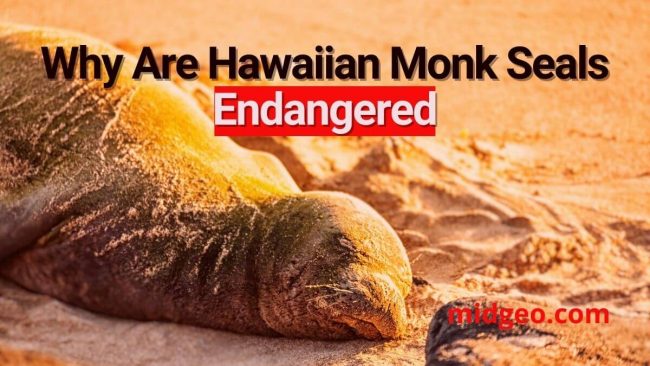Hawaiian Monk Seal Adaptation – Endangered Marine Animals

Hawaiian Monk Seal (Neomonachus schauinslaug)
Hawaiian Monk Seals
Hawaiian Monk seals are solitary individuals that can live around 30 years. Males monk seals can reach around 7 ft (2.1 m) in length while females grow larger to around 8 ft (2.4 m). Females can weigh up to 600 lbs (270 kg). Female monk seals carry their babies for 10 to 11 months. At birth, a monk seal pup will already be over 3 ft (.9 m) in length. Male monk seal can be quite aggressive.
They sometimes mob females in order to be the first one to mate. This can lead to injuries to the female. Monk seals usually haul out on land to give birth, molt, or rest. Molting takes place once every year. If you see a monk seal resting on a beach, do not disturb it. It is saving up energy so it can hunt again. If the seal is constantly disturbed, it won’t have the proper amount of energy to feed, making it more vulnerable to predators. If there is a mother and her pup on the beach,
And the mother is scared off, she may not come back for her pup. A monk seal mother will remain on land and fast, during the approximately one month period of nursing her pup. Then, the mother will abandon her pup and return to the sea.
Hawaiian Monk Seal Adaptation
The warm temperature of the Hawaiian Islands is a challenge for the Hawaiian seal monks. The entire species has a remarkable ability to adapt to its surroundings.

They are well-suited to the tropical environment of the Hawaiian Islands.
They use the cold of the water to keep themselves cool, and the warmth of the sun and sand to warm up during a lengthy slumber.
Hawaiian seal monks store fat like polar seals to keep warm in cold water.
Their streamlined bodies allow them to swim more quickly.
Monk seals evolved to the need to swim fast by developing flipper-like front and rear limbs to propel them through the water. Because of their aerodynamic body structure, monk seals have streamlined bodies that make them exceptional swimmers.
Hawaiian Monk Seal Facts

- *Hawaii monk seals weigh up to 7 feet (2.1 m) in length and produce up to 476 kg.
- *They are endemic to the Hawaiian Islands and Johnston atoll located approximately 1,000 miles southwest of Hawaii.
- *They shed their upper layer of fur each year in a fast process called a ‘catastrophic moult’.
- *we can find The seals sleeping on beaches during the day .
- *They can dive deeper than 1,804 feet (550 m) but they prefer to swim in shallow water 100 feet (61 m). The seals can sleep on cave soils overnight.
- *Hawaiian monk seals forage near the seafloor and consume a wide variety of food depending on what is available.
- *This can include small fish, squid, octopus, and crustaceans. Seals dive in order to hunt for their food and spend two thirds of their time at sea.
- *Most dives are around 200 ft (61 m) in depth. However, seal have been recorded diving over 1800 ft (550 m) deep.
Why Are Hawaiian Monk Seals Endangered?
The Hawaiian monk seal is one of the most endangered seals in the world. They are endemic to the Hawaiian Islands meaning that they are found nowhere else in the world.

Only around 1400 of these seals exist today since humans hunted them to near extinction in the 19th and 20th centuries. Their recovery has been very slow due to numerous problems including human disturbance on beaches, pollution, and fishing net entanglement.
Click To Read…
MidGeo
Most Endangered Marine Animals Due To Plastic Pollution
Most Endangered Ocean Species and Marine Animals
They are also subject to being preyed upon by tiger sharks and Galapagos sharks.
How many Hawaiian monk seals are left?
There are only around 1,400 Hawaiian monk seals remaining in the world, and their number is only about a third of what it was in the past. With such tiny numbers, each seal’s life may be assessed in terms of its influence on population growth or decrease.
Are Hawaiian monk seals friendly?
Unless they are threatened, most monk seals are not hostile toward humans. Only a handful of recorded examples of hostile encounters between seals and humans have been documented.
Why can’t you touch a monk seal?
Touching, harassing, capturing, injuring, or killing monk seals is a class C crime. Violators might face jail time or fines if they break the law. So, be careful about doing something like that.
How often do Hawaiian monk seals give birth?
Birthing occurs throughout the year, with the months of March and April being the busiest. Puppies care for five to six weeks after birth. Female monk seals period of pregnancy between the ages of five and nine.
Are monk seals rare?
The Hawaiian monk seal is a rare tropical exception to the rule that seals prefer cold water. The isolated Northwestern Hawaiian Islands are home to Hawaiian monk seals. These tiny islands and atolls are either deserted or have a low human population.
Where can I see Hawaiian monk seals?
Because it is so near to their major feeding areas, the Hawaiian island of Kauai is the most probable site to see monk seals. Monk seals are frequently spotted basking on Poipu Beach on Kauai, making it a popular place for sightings.
What is the rarest seal?
Many people are unaware that Lake Saimaa is home to the Saimaa Ringed seal, the world’s rarest seal. Ringed seals of the Saimaa subspecies live in freshwater. They are descended from ringed seals and were split from the others as the land rose after the last ice age, separating them from the rest.
However, if you have any questions about the “Hawaiian monk seal adaptation and endangered marine animals” topic. Then comment on me.





